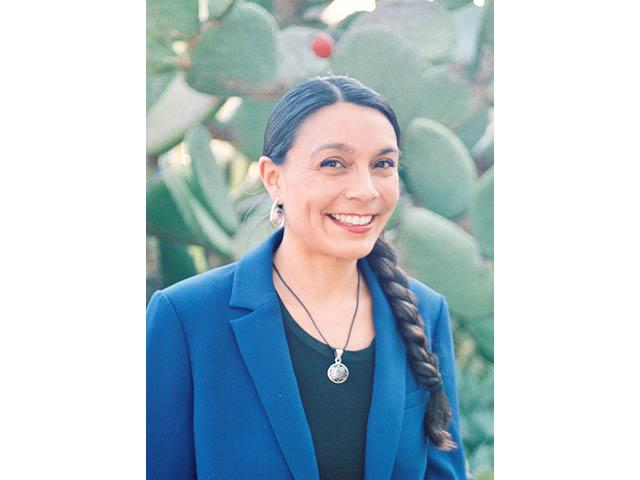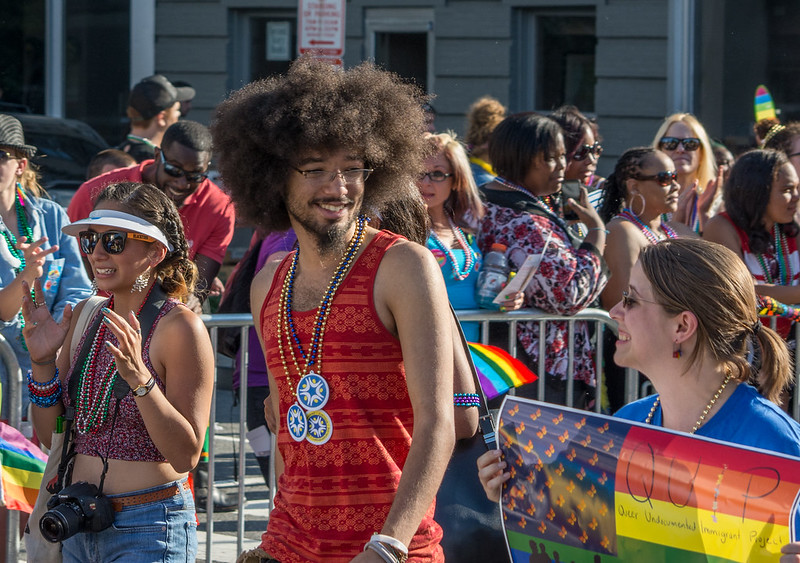7.5 Belonging is Social Justice
Kimberly Puttman
As we construct new ideas related to family, belonging, and autonomy, one group of activists draws our attention. They are the Queer Dreamers, sometimes called the “undocu-queers.’” These young people started organizing in early 2000 to advance immigrant and queer rights.
Undocuqueer [undocumented and queer] leaders have been very visible in the immigrant rights movement in recent years. They have been at the forefront of many of the major protests and actions for the DREAM Act. One activist says, “I believe they have played a critical role in making sure that the public becomes aware of our situation and how we are fighting for our rights in this country (Terriquez 2015:344).”

Figure 7.28. Veronica Terriquez is a sociologist and the director of the Chicano Research Studies Center at UCLA.
Veronica Terriquez, a sociologist at UCLA was interested in finding out more about the relationship between coming out as queer and undocumented. She also wanted to find out if the two social movements—immigrant’s rights and queer rights—supported each other or remained separate movements.

Figure 7.29. These queer undocumented people are marching in the Washington DC Pride Parade. How is their work intersectional?
Movement activists worked to pass the Dreamers act and DACA, described earlier in the chapter. The social movement work involved in passing DACA was widespread, particularly in California, the state with the largest undocumented youth population (Terriquez 2015:344). Some young people organized a “Coming Out of Shadows” campaign (Sirriyeh 2018). This campaign encouraged undocumented people to talk about their undocumented status. The strategy was inspired by the lesbian and gay process of coming out— telling people you were gay or lesbian. By going public with their undocumented identity organizers hoped to break the social stigma of being undocumented and gain popular support for DACA. By borrowing an effective social movement technique, immigration organizers became more effective, which is collective action at work.
However, as sociologists, we want to understand more about the sequence of events to begin sorting out correlation and causation. More specifically, Terriquez wanted to know whether undocumented queer youth came out as queer first and then were brave enough to share their undocumented status or whether the opposite was true.
She found that although many youth came out with both statuses simultaneously, most youth came out as undocumented first and then as queer. She cites two reasons for this directionality.
First, as discussed in this chapter, people who are undocumented have to rely on family support to survive in their new country. Family support is crucial to their survival because they aren’t legally allowed to work and, for the most part, don’t have access to insurance or other social safety net programs. The challenges to coming out are both physical and cultural. Terriquez provides this detail from Samir, a 24-year-old activist:
We can’t [legally] have jobs, so we already have these financial issues. Once you come out to your family—and if they don’t respond very well—then there is that chance of losing your bed, a place to sleep. There’s a lot more you can lose because you can’t really take care of yourself financially when you’re undocumented. (Samir in Terriquez 2015:252)
These words from Alberto, a 26-year-old activist from Mexico, highlight the cultural barriers to coming out in a conservative Catholic immigrant family:
My dad belonged to one of the most conservative organizations within the Catholic Church, and he was very vocal about his distaste for certain things, including homosexuality. So, I thought it was wrong to be gay because I grew up in that environment. (Alberto in Terriquez 2015:251)
Coming out as queer can be a significant emotional and economic risk for immigrant youth.
Second, Terriquez finds that the experience of organizing for immigrant rights and coming out of the shadows empowers youth. As they experience the support they need to be more visible in their undocumented identity, they are more willing to share their queer identity. She writes, “As Ixchel, a prominent and openly bisexual leader explained, being open about one’s legal status ‘is a transition that helps queer folks come out; they experience the acceptance of coming out as undocumented, so it helps people come out as queer’” (Terriquez 2015:253).
However, this order of coming out is not just about individual agency. It is also supported by the conscious choice of some immigrant rights organizations, particularly at universities and colleges, to engage in intersectional analysis. These organizations were deliberately welcoming to people with multiple oppressed identities. “Contributing to the intersectional mobilization of undocumented LGBTQ activists, this multi-identity work included deliberate efforts by leaders to combat homophobia as well as organizational practices that validated the experiences of LGBTQ members” (Terriquez 2015:354).
In other words, some youth Dreamer organizations recognized that in addition to being undocumented, many of their members experienced oppression as women, queer or trans, or poor people. They understood the intersectionality of the oppression they were collectively facing and leveraged their diversity as a strength of their movement.
Figure 7.30. In this 3:25 minute video UndocuQueer Manifesto queer undocumented youth assert their truth—that they can’t be only queer or only undocumented. They are both and deserve acceptance in whatever community they find themselves. Transcript
Some queer dreamers were not supported by wider immigrant rights organizations because they were queer. Some queer dreamers did not get support from campus LGBTQ organizations because they were Black, Brown, or Indigenous. In many cases, they formed their own social movement organizations to be their whole selves and access the political power that brought them. They created a manifesto, which they describe in Figure 7.30. They created belonging in their own chosen families, families from the heart/familias de corazón. Julio Salgado is a Latinx artist who creates art to illustrate his life and the lives of other undocumented queers. If you’d like to learn more about his story, you can watch this 4.46 minute video, How Julio Salgado Utilizes Art to Express Life As a Queer, Undocumented Man
.
By coming out as queer and undocumented, these immigrant youth are fighting for social justice for themselves and their families. By expanding what it means to be family, more of us can belong. Belonging is social justice.
7.5.1 Licenses and Attributions for Belonging is Social Justice
Open Content, Original
“Belonging is Social Justice” by Kimberly Puttman is licensed under CC BY 4.0.
Open Content, Shared Previously
Figure 7.29. “Photo of UndocuQueers marching in DC” by Tim Evanson is licensed under CC BY-SA 2.0.
All Rights Reserved Content
Figure 7.28. “Photo of Veronica Terriquez” by Ernesto Chavez, UCLA is included under fair use.
Figure 7.30. “UndocuQueer Manifesto” by United We Dream is licensed under the Standard YouTube License.
